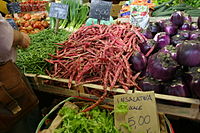Dragon tongue bean, or dragon tongue shelling bean, is young green bean (snap bean)[3] of cranberry bean, pinto bean in the species Phaseolus vulgaris (shell bean).
 | |||||||||||||
| Nutritional value per 132.8 g | |||||||||||||
|---|---|---|---|---|---|---|---|---|---|---|---|---|---|
| Energy | 0.874456 kJ (0.209000 kcal) | ||||||||||||
19.5 g | |||||||||||||
| Sugars | 1 g | ||||||||||||
| Dietary fiber | 5.4 g | ||||||||||||
12.9 g | |||||||||||||
| Saturated | 1.9 g | ||||||||||||
6.8 g | |||||||||||||
| |||||||||||||
| †Percentages estimated using US recommendations for adults,[1] except for potassium, which is estimated based on expert recommendation from the National Academies.[2] Source: Caloriecount.com | |||||||||||||
Other names for this Heirloom Bush yellow wax dwarf bean include Dragon Langerie, Merveille de Piemonte and Meraviglia del Piemonte.[4]
Characteristics
editDragon tongue bean is a flavorful, juicy bean whose seeds are encased in a buffed colorful pod with mottled burgundy patterns throughout the shell's surface. The shelled beans are pale pistachio green in color, their size, petite, and their shape, ovate and slightly curved.[5]
Days to maturation is approximately 55-60 days.[6]
Fully grown plant height is approximately 2-3 feet tall.[7]
Time from flower to bean is approximately 12 to 15 days.[8]
Growing requirements
editSoil Temperature required for Germination: 60–85 °F[9]
Seed Depth: 1"[10]
Seed Spacing: 4"[11]
Row Spacing: 18–36"[12]
Fertilizer Needs: Low[13]
Uses
editDragon tongue bean can be harvested, picked and used for their pods as well as for their seeds like a green bean (snap bean) or allowed to mature into a shell bean for using their seeds only.[14]
References
edit- ^ United States Food and Drug Administration (2024). "Daily Value on the Nutrition and Supplement Facts Labels". FDA. Archived from the original on 2024-03-27. Retrieved 2024-03-28.
- ^ National Academies of Sciences, Engineering, and Medicine; Health and Medicine Division; Food and Nutrition Board; Committee to Review the Dietary Reference Intakes for Sodium and Potassium (2019). "Chapter 4: Potassium: Dietary Reference Intakes for Adequacy". In Oria, Maria; Harrison, Meghan; Stallings, Virginia A. (eds.). Dietary Reference Intakes for Sodium and Potassium. The National Academies Collection: Reports funded by National Institutes of Health. Washington, DC: National Academies Press (US). pp. 120–121. doi:10.17226/25353. ISBN 978-0-309-48834-1. PMID 30844154. Retrieved 2024-12-05.
- ^ Garrelts, C.; Garrelts, Megan; Lee, Bonjwing (2011). Bluestem: The Cookbook. Andrews McMeel Publishing. p. 71. ISBN 978-1-4494-0061-3.
- ^ "Dragon Tongue Beans". Cornell University. Retrieved 22 July 2021.
- ^ "Dragon Tongue Shelling Beans". Specialty Produce. Retrieved 15 September 2016.
- ^ "History Of Dragon Tongue Beans". gardeningknowhow.com. 10 December 2015. Retrieved 26 August 2021.
- ^ "Grow This: Dragon's Tongue Bean". hobbyfarms.com. 18 May 2015. Retrieved 26 August 2021.
- ^ "Grow This: Dragon's Tongue Bean". hobbyfarms.com. 18 May 2015. Retrieved 26 August 2021.
- ^ "Dragon Tongue". territorialseed.com. Retrieved 26 August 2021.
- ^ "Dragon Tongue". territorialseed.com. Retrieved 26 August 2021.
- ^ "Dragon Tongue". territorialseed.com. Retrieved 26 August 2021.
- ^ "Dragon Tongue". territorialseed.com. Retrieved 26 August 2021.
- ^ "Dragon Tongue". territorialseed.com. Retrieved 26 August 2021.
- ^ "What is a Dragon Tongue Bean?". wiseGEEK. Retrieved 15 September 2016.
Further reading
edit- Iannotti, M. (2012). The Beginner's Guide to Growing Heirloom Vegetables: The 100 Easiest, Most Flavorful Vegetables for Your Garden. Timber Press. pp. 94–96. ISBN 978-1-60469-188-7.